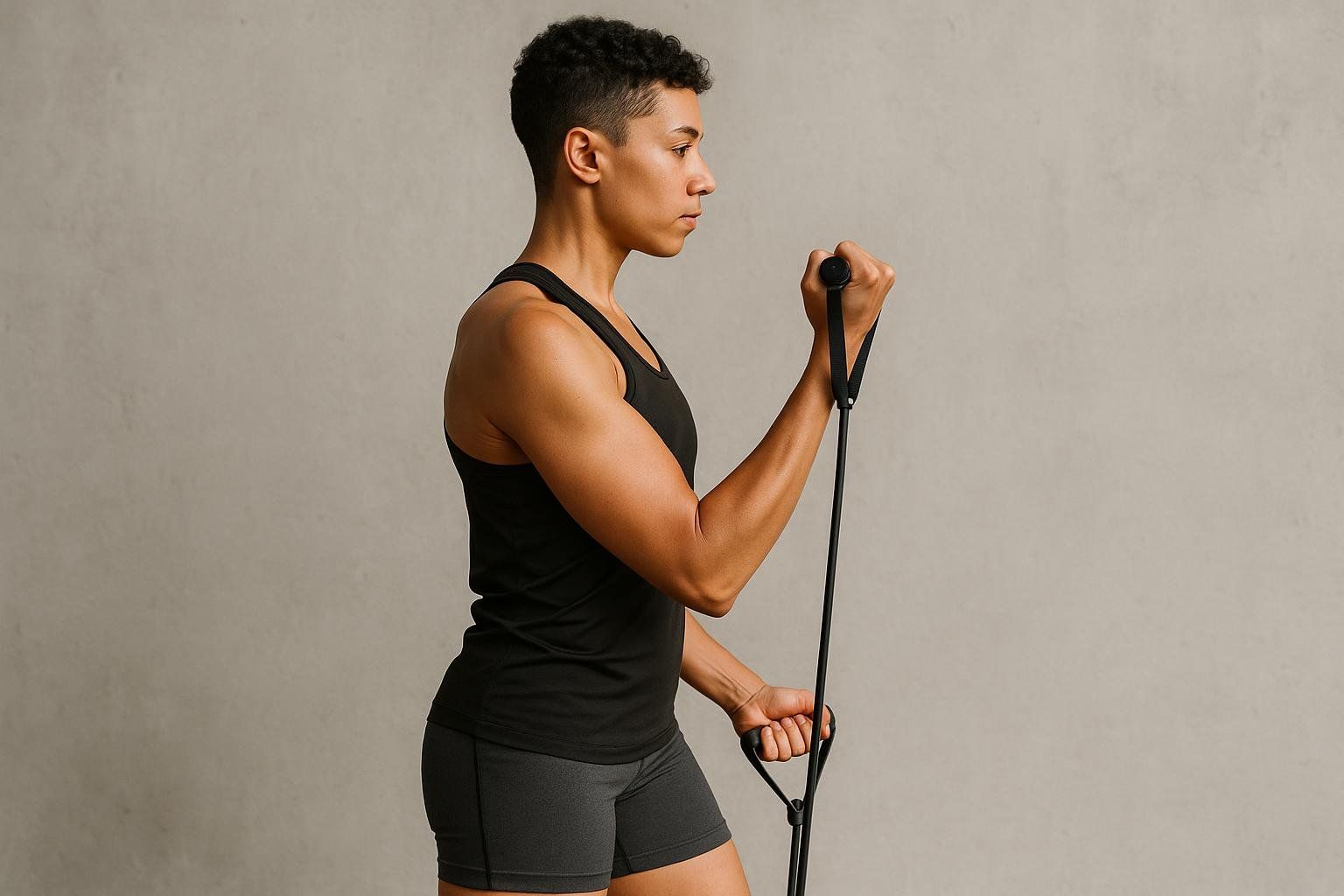Resistance Bands: A Buyer’s Guide for Strength and Rehab

Resistance Bands: A Buyer’s Guide for Strength & Rehab
Looking for a compact, affordable way to build strength anywhere? A 2019 systematic review found that elastic resistance training can produce strength gains similar to free weights when programmed well. Bands are portable, beginner‑friendly, and scale from gentle rehab to hard strength work.
Quick answer (what to buy):
- Home gym, general strength: A set of 41-inch flat loop bands (light, medium, heavy) + a door anchor. These cover presses, rows, squats, and pull‑up assistance. Example ranges at 100% stretch: ~9–225 lb depending on thickness (Rogue Monster Bands).
- Rehab or yoga integration: Flat therapy bands in lower resistances (e.g., yellow/red/green). Within TheraBand, color steps increase pull force by ~25% from Yellow→Black and ~40% into Silver→Gold (TheraBand force chart). For latex sensitivity, choose a clearly labeled latex‑free option and confirm with your clinician (latex allergy information).
- Travel and glute activation: Mini-loop bands (fabric or latex) for bridges, lateral walks, and warm‑ups. Fabric rolls less on thighs.
- Coaches/trainers: Stock a full loop-band spectrum for progressive overload, plus handle-tubing for quick setups. Track wear and replace bands at the first signs of damage (Power Systems care tips).
- New or returning to training? Use effort to guide your first sessions. Our guide to the Rate of Perceived Exertion (RPE) shows exactly how hard to work.
What are resistance bands? Types and best uses

Think of resistance bands as stretchy strength tools—the more you pull, the more they resist. That rising tension makes them effective for building strength and control. Common types include flat therapy bands, 41‑inch flat loops, tubing with handles, short mini‑loops, and figure‑8/ring bands. For clinical how‑tos and safe at‑home routines, the British Heart Foundation offers a guide to safe home routines.
Materials: latex, non‑latex, and fabric
- Natural latex rubber: Common, stretchy, and durable—but can trigger latex allergy in some people.
- Non‑latex options: Available for those with sensitivities; look for “latex‑free” labeling.
- Fabric hip bands: Less stretch range but they don’t roll as easily on thighs and feel comfy for lower body work.
Resistance levels and color codes (read this before you buy)
- Colors are brand‑specific. A “red” band from one brand may not match another.
- Resistance depends on stretch. The farther you pull, the more force you feel. Bands list pull force at a specified elongation (often 100%), but exact numbers vary by brand and thickness—check the manufacturer’s force chart before buying.

How to choose your starting level
- Upper body: Pick a band that allows 10–15 smooth reps with 2–3 “in reserve.”
- Lower body: Most people can start one step heavier.
Safety and setup (read this before your first session)
A few simple habits go a long way:

- Inspect before each use. Look for cracks, nicks, thinning, or loose connections; replace if you spot wear, according to guidance from the ACSM.
- Anchor smart. Use proper door anchors or sturdy posts; avoid sharp edges.
- Don’t overstretch. Avoid stretching bands beyond the manufacturer’s recommended limit; Power Systems advises staying under about 2.5× the resting length.
- Control the return. Control the return phase of the movement; do not let the band snap back.
- Medical considerations: If you have a heart condition or high blood pressure, talk to your clinician first. The British Heart Foundation provides safe routines and tips (BHF band exercises).
Ready to train? Try our beginner resistance band exercise guide.
Durability, maintenance, and replacement
Treat bands well and they’ll last longer—and snap less:

- Store smart: Keep away from sun/UV and heat; oils/lotions can degrade rubber.
- Clean right: Mild soap + water works; then air‑dry fully. If used in pools, rinse off chlorine/salt. Avoid harsh cleaners and direct sunlight when drying.
- Use within limits: Avoid stretching beyond ~2.5× length and contact with sharp/gritty edges.
- Inspect regularly: Replace bands at the first sign of fraying, cracks, or thinning; frequent users may benefit from a scheduled replacement cadence.
Are resistance bands effective for building strength?

Yes. Elastic resistance training has produced strength gains comparable to traditional free‑weight/machine training across a wide range of people—according to a 2019 systematic review. For power and explosiveness, adding bands to free weights (often called “accommodating resistance”) boosted short‑term jump performance in a 2024 study. Broader evidence from a 2022 meta‑analysis also supports variable resistance for strength gains.
Comparison table: Which band fits your use case?
| Band type | Best for | Pros | Cons |
|---|---|---|---|
| Flat therapy band | Rehab, gentle strength, mobility | Portable, precise increments | No handles; anchoring needed |
| 41-inch loop band | Full-body training, pull-up assist, home gym | Very versatile; wide resistance spectrum | Requires learning wraps/anchors |
| Tubing with handles | Quick setups for rows/presses | Comfortable grip; door-friendly | Less versatile for lower body |
| Mini/fabric hip loops | Glute/leg activation, warm-ups | Won’t roll easily; compact | Limited range of motion |
| Figure‑8/ring bands | Isolation moves, small spaces | Built‑in handles; simple | Short length limits versatility |
Programming and progress tracking
- Frequency: 2–3 full‑body sessions/week works for most; progress by moving to a thicker band or adding reps/sets.
- Intensity: Use perceived effort so you don’t under‑ or overshoot.
- See what’s changing: To track your progress accurately—especially if weight loss isn’t your primary goal—consider periodic body composition analysis. BodySpec DEXA scans measure muscle and fat (including visceral fat) precisely, so you’ll know your plan is working even when the scale doesn’t budge. Learn more in Body Composition vs. Weight and our standards for accurate, repeatable results. When you’re ready, book your DEXA scan.
FAQs
- Do different brands share the same color strengths? No—band colors are brand‑specific. Always check the manufacturer’s force chart.
- Will bands aggravate my joints? Bands are often considered joint‑friendly because the resistance is variable. However, start slowly and consult a professional if you have joint concerns.
- Latex allergy—what should I buy? Choose latex‑free bands and verify labeling; when in doubt, consult your clinician.
- How do I care for my bands? Keep away from heat/UV, clean with mild soap/water, dry thoroughly, avoid over‑stretching, and inspect regularly.
- Where can I find beginner exercises? We have a complete beginner’s guide to resistance band exercises.
Bottom line
Resistance bands are portable, scalable, and surprisingly powerful for strength, mobility, and rehab. Choose the type and material that fit your goals, size resistance with a brand’s force chart, train by feel, and care for your bands to extend their life. To confirm your progress beyond the scale, track with a BodySpec DEXA scan—it’s fast, precise, and easy to book. Book your DEXA scan.


